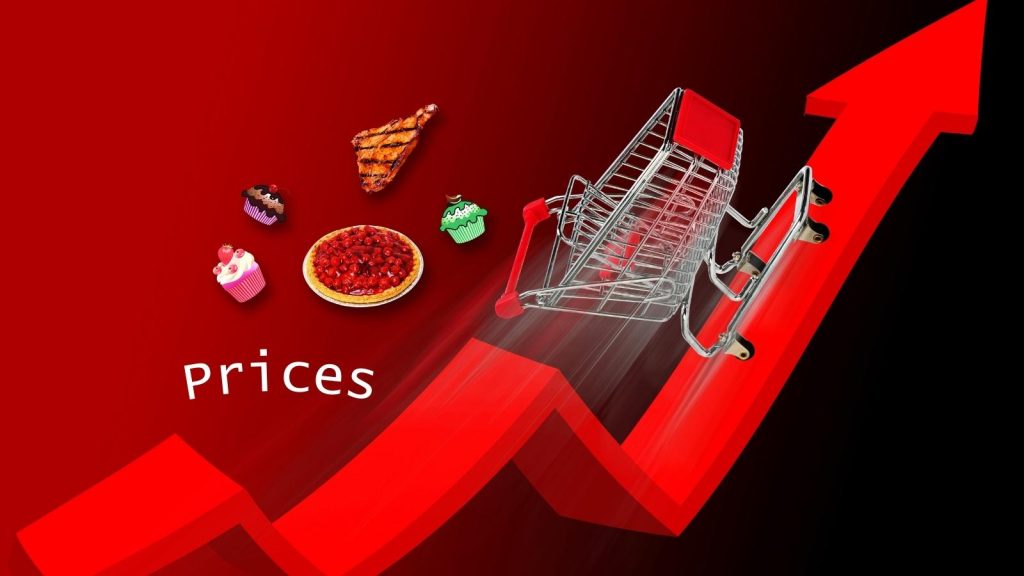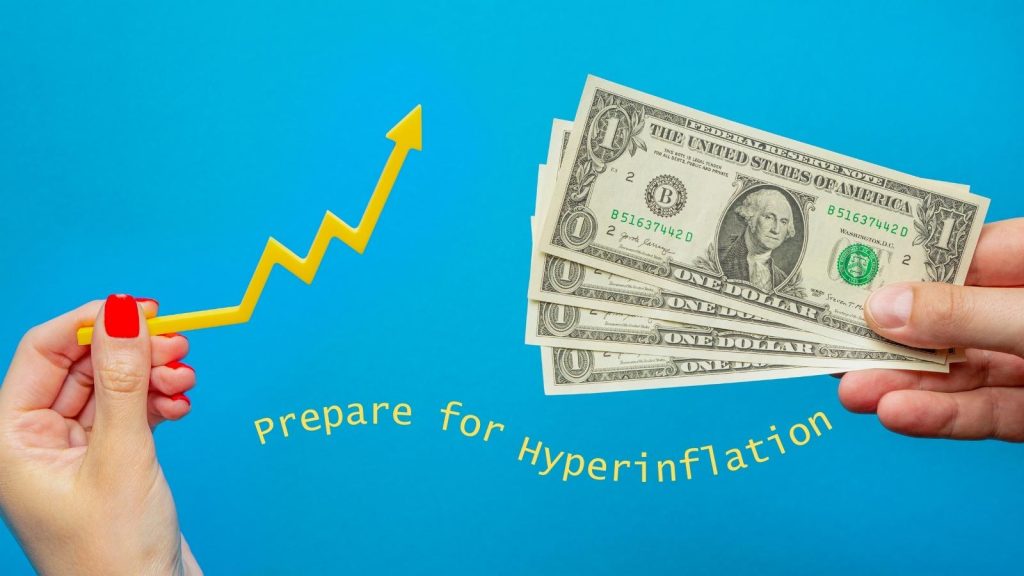Hyperinflation can significantly disrupt the financial landscape, posing a formidable challenge for small businesses. As prices soar and currency value plummets, businesses face the urgent need to adapt swiftly to survive the turbulent economic climate. Preparation is key in how to prepare for hyperinflation for your small biz.
If you have gone food shopping or filled up your vehicle with gas you know how prices have gone up again recently.
In this blog post, I will delve into essential strategies to help small business owners proactively navigate the complexities of hyperinflation.
By understanding the potential repercussions of hyperinflation and taking decisive actions to safeguard their finances, entrepreneurs can fortify their businesses against the tumultuous effects of rapid inflation.
Stay tuned to discover practical tips and proactive measures to shield your small business from the adverse effects of hyperinflation and ensure financial stability in volatile economic conditions.
Table of Contents
Understanding Hyperinflation
Hyperinflation is a rapid and excessive increase in the overall prices of goods and services within an economy. Unlike regular inflation, which is a steady rise in prices over time, hyperinflation occurs at a much faster rate, leading to a loss of confidence in the currency and a breakdown of the monetary system.
This extreme inflationary environment can have devastating effects on businesses, especially small enterprises trying to navigate through uncertain economic conditions.
What Is The Difference Between Inflation and Hyperinflation?
Inflation and hyperinflation are vastly different economic situations. Inflation refers to a general rise in prices over time, often caused by an increase in money supply or demand outpacing supply. It’s considered normal and manageable when kept within a low single-digit range.
Hyperinflation, however, is an extreme and uncontrolled situation where prices skyrocket rapidly, sometimes doubling within days or hours. It renders a currency virtually worthless and devastates an economy.
While inflation erodes purchasing power gradually, hyperinflation can wipe out savings overnight.
Governments must take drastic measures to control hyperinflation, like instituting a new currency or implementing strict monetary policies.
Causes of Hyperinflation:
Hyperinflation is often triggered by a combination of factors, including excessive money printing by central banks, economic instability, and political unrest. When a government prints an abundance of money without the necessary economic output to support it, the value of the currency diminishes rapidly.
This excessive increase in the money supply can lead to a spiraling cycle of price increases, further eroding the purchasing power of consumers and businesses alike.
Impact on Small Businesses:
Small businesses are particularly vulnerable to the effects of hyperinflation. The decreased purchasing power of consumers can result in lower sales and revenue for small enterprises.
Additionally, the rising costs of goods and services can eat into profit margins, making it challenging for businesses to sustain their operations. Pricing products and services become a constant challenge as businesses struggle to keep up with the rapidly changing economic landscape.
Not only that but a business also pays for gas, electricity, and other goods and services to run their small businesses.
Adapting to hyperinflation requires resilience and strategic financial planning to withstand the volatility and uncertainty it brings.
Countries such as Zimbabwe, Venezuela, and Germany have experienced episodes of hyperinflation in the past, with businesses facing massive challenges in maintaining operations, pricing goods, and navigating the unpredictable economic environment.
Businesses that survive hyperinflation emerge with valuable lessons in financial management and adaptability, having weathered one of the most severe economic storms imaginable.
Strategies How To Prepare For Hyperinflation
In times of hyperinflation, small businesses need to be proactive in their approach to financial planning, cost management, and pricing strategies to ensure their survival and sustainability.
Here are some actionable steps that small business owners can take to mitigate the impact of hyperinflation and safeguard their operations:
Financial Planning For Hyperinflation
Effective financial planning is crucial during hyperinflation. Small business owners should prioritize budgeting to track expenses meticulously, identify areas for cost-saving, and ensure financial stability.
Diversifying revenue streams can help offset the effects of inflation on specific products or services.
Moreover, managing cash flow effectively by monitoring receivables and payables can prevent liquidity issues.
Cost Management
Controlling costs is essential in a high-inflation environment. Small businesses can renegotiate contracts with suppliers or landlords to secure better terms or explore barter arrangements to exchange goods or services without cash transactions.
Optimizing inventory management by reducing excess stock levels and focusing on fast-moving items can minimize losses due to rising prices.
Price Adjustments To Prepare For Hyperinflation
Adjusting prices strategically is key to surviving hyperinflation while maintaining customer loyalty. Small business owners should conduct thorough market research to understand competitors’ pricing strategies and customer purchasing power.
Incremental price adjustments coupled with value-added services or products can help justify price increases without alienating customers. Offering discounts on bulk purchases or loyalty programs can also incentivize repeat business.
By implementing these strategies, small businesses can adapt to the challenges posed by hyperinflation, protect their bottom line, and position themselves for long-term success in a volatile economic environment.

Stock Up On Inventory
With hyperinflation looming, it’s crucial to add stock to your inventory now. Don’t wait until prices skyrocket – get what you need while costs are still manageable.
Businesses that act quickly can secure essential goods at reasonable rates, safeguarding their bottom line. Those who procrastinate will face supply shortages and exorbitant markups.
Take proactive steps to protect your company’s financial stability. Stockpile inventory judiciously to ride out the inflationary storm.
Building Resilience
In today’s dynamic business landscape, preparing your small business for potential economic upheavals like hyperinflation is paramount.
Building resilience within your business can mean the difference between thriving in adversity or facing insurmountable challenges.
Emergency Fund For Hyperinflation
In the face of hyperinflation, establishing an emergency fund is a prudent step to shield your small business from unexpected financial jolts. Begin by setting aside a portion of your revenue consistently to build a financial buffer.
Ensure this fund is easily accessible yet separate from your operational accounts.
By maintaining a robust emergency fund, you can navigate sudden price hikes, currency devaluation, or supply chain disruptions without jeopardizing your business’s core operations.
Adaptability and Innovation
Adaptability and innovation are the cornerstones of resilience in times of economic turmoil. Stay attuned to market shifts and consumer trends, and be prepared to adjust your products or services accordingly.
Embrace a mindset of continuous improvement and explore innovative ways to add value to your offerings.
By remaining agile and proactive, your small business can pivot swiftly to meet evolving customer demands and stay ahead of the competition in hyperinflationary environments.
Risk Assessment
Conducting regular risk assessments is essential for identifying and mitigating potential threats stemming from hyperinflation. Assess the impact of currency devaluation, inflation spikes, or supply chain disruptions on your business operations.
Develop contingency plans and risk mitigation strategies to address vulnerabilities and safeguard your business’s continuity. By proactively assessing risks and implementing preventive measures, you can fortify your small business against the uncertainties brought about by hyperinflation.
In essence, building resilience is not merely about surviving economic challenges; it’s about thriving in the face of adversity. By cultivating a culture of preparedness, adaptability, and risk awareness, your small business can weather the storm of hyperinflation and emerge stronger on the other side.
Stay proactive, stay innovative, and stay resilient – your business’s future success depends on it.
How To Prepare For Hyperinflation By Seeking Professional Advice
Before making any decisions regarding preparing your small business for hyperinflation, seeking professional advice is crucial. Here are key sub-sections to consider when consulting with experts:
Financial Advisors
Financial advisors specialize in providing financial guidance and investment strategies tailored to your specific business needs.
They can help you assess your current financial situation, develop a plan to mitigate the impact of hyperinflation, and recommend investment opportunities that align with your business goals.
Economists
Consulting with economists can provide valuable insights into the economic landscape and how hyperinflation may affect your business.
Economists can analyze market trends, inflation rates, and economic forecasts to help you make informed decisions on pricing strategies, cost management, and financial planning to navigate through uncertain economic times.
Business Consultants
Business consultants offer expertise in various aspects of running a business, including operations, marketing, and strategic planning.
When preparing for hyperinflation, business consultants can help you identify areas of your business that may be vulnerable to inflationary pressures and develop contingency plans to minimize risks and maximize growth opportunities.
By engaging with professionals such as financial advisors, economists, and business consultants, small business owners can gain valuable insights and expert guidance to navigate the challenges posed by hyperinflation.
Remember, leveraging their expertise can provide you with strategic advantages and help safeguard your business’s financial health in times of economic uncertainty.
Conclusion Of Preparing For Hyperinflation
In the face of hyperinflation, the resilience of small businesses hinges on proactive planning and readiness. By staying informed, diversifying revenue streams, and adjusting pricing strategies, entrepreneurs can navigate the challenges posed by escalating inflation rates.
Embracing adaptability and staying agile in the marketplace will be key to not just surviving, but thriving in a hyperinflationary environment. Remember, preparation is the cornerstone of small business success in turbulent economic times.
Stay vigilant, stay prepared, and stay ahead of the curve to secure your small business’s future.
How are you preparing today for hyperinflation to hit?
How To Prepare For Hyperinflation: Is Your Small Biz Ready? Share on X



